Everyone loves the pure white flowers of peace lilies. Even when they are not in bloom, the glossy, sophisticated leaves of these majestic plants are a sight to behold! However, no matter how magnificent and majestic its flowers are, they sometimes start to turn brown and black and eventually fall off the plant. So, if you are experiencing the same issue and are clueless about what is wrong, what can you do? This article about peace lily flowers turning brown or black is for you!
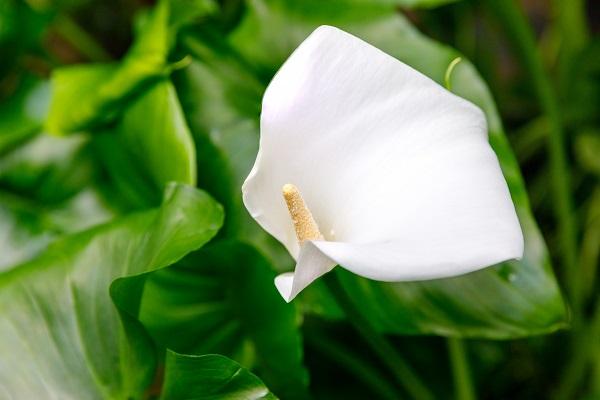
The peace lily is a well-liked houseplant with bright white blossoms and dark green leaves.
White flowers of peace lily can turn brown or black for a variety of reasons. The first and obvious reason can be that the peace lily flower has reached the end of its life cycle, which is about two to three weeks. If that’s the case, you should not be worried (if your plant is otherwise healthy). However, if peace lily flowers are turning brown prematurely, i.e., before two or three weeks, you should look for other causes.
For example, lack of care, unhealthy watering routine, over-fertilization, stress, diseases like ringspot virus, and pest invasions.
Let us take a look at these issues one by one, their possible solutions, and see how you can make your peace lily flowers last a little bit longer.
Related: Peace Lily: Top Reasons Why They Droop and How To Fix Them
Why Are My Peace Lily Flowers Turning Brown?
When the flowers of a peace lily have reached the end of their life cycle, they will naturally turn brown. It is quite natural, and you have no reason to be concerned about it so long as your plant is healthy in all other aspects. However, there could be instances where blossoms prematurely turn brown. So, let’s look at how to make the flowers stay longer, remove the flowers that fade, and why the flowers turn brown (including care-related causes).
Peace Lily Flowers Turning Brown Due To Stress
A plant that is under stress is unhappy. When plants are forced to grow in less-than-ideal settings, they feel stressed. These conditions may be brought on by factors such as underwatering, overwatering, under-fertilizing, or over-fertilizing the plant, exposing the plant to sunlight for extended periods, and having low humidity levels around the peace lily plant.
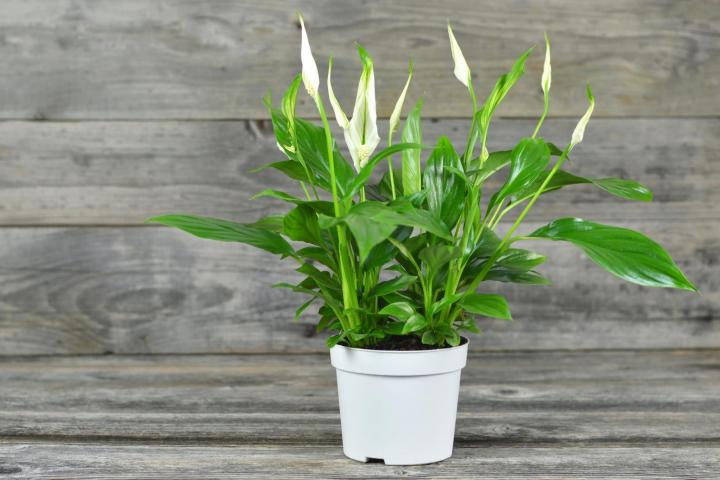
A lack of water or too much humidity can cause peace lily blossoms to become brown or even black.
In extreme situations, the peace lily may not recover from the impacts of these factors and die. So, let’s look at why your peace lily flowers are in such poor condition and how you might improve their health.
Lack Of Water
There is a chance that you are not providing your peace lily with sufficient water. If your plant is short on water, you may notice that the tops or edges of the blooms have turned brown. Also, the leaves will start to turn yellow, fall off more often, and wilt as time goes by.
Examine the soil by putting your finger to the first knuckle to see if your peace lily is receiving adequate water. If it feels dry, your peace lily is underwatered. Checking the moisture content of the soil can also be done with the help of a soil moisture meter. If the number on the meter is three or lower, the plant is receiving an inadequate amount of water.
Fix
Water the peace lily until it drips through the drainage holes at the container’s bottom. Always use high-quality potting soil that can absorb and retain a lot of water. Also, if you tend to forget to water your plants on a regular basis, a reminder can help.
Overwatering
Another reason your peace lily blossoms are becoming brown or black is because they are getting too much water. When there is too much water in the soil, it will remain damp for several days after it has been watered.
There are two potential causes for the overwatering of your plants: the first and most obvious is that you are providing an excessive amount of water. The second possibility, which may not be immediately apparent, is that the drainage hole in the plant pot is clogged.
The soil becomes boggy due to overwatering, which encourages the growth of bacteria and fungi. When these bacteria and fungi begin to attack the roots of the plants, the plants develop a condition known as root rot. When roots become rotten, they are no longer able to absorb nutrition, which causes the leaves and blossoms to become brown.
Fix
Stop giving your peace lily any more water and wait until the top of the soil feels completely dry. Additionally, make sure that the drainage holes at the bottom of the container are not clogged in any way, and clean them if they are. In the future, just water your peace lilies when the top 1 inch of soil seems dry.
Related: How To Save An Overwatered Peace Lily From Dying? A Comprehensive Guide
Direct Sunlight
Even though it is grown inside, the peace lily requires a lot of bright indirect sunshine. However, if a peace lily is kept in a location where it receives direct sunlight, the plant will feel stressed, and this will show in its blossoms. The flower will have a fragile appearance and become brown, and the foliage will look like it has wilted.
Fix
Keep your peace lilies in a brightly lit room if you want to keep them indoors. They should be at a safe distance from the window where they are not in direct sunlight. Make sure you provide them shade if you have planted peace lilies in the garden.
Low Humidity
The yellowing of your peace lily’s blossoms may also be attributable to the low humidity in your house. Dehydration occurs more rapidly in low-humidity environments because water is lost more easily from the plant. Once the petals have lost their moisture, the flowers will wilt and turn brown. In addition, due to dehydration, the leaves will also begin to wilt to conserve water, which will put the plant under even more stress, causing it to turn brown.
Fix
You should mist your plants a few times a week to maintain a high humidity level. The humidity in the space can also be raised by making use of a humidifier in the area.
You may also create a microclimate that is beneficial to your plants by keeping them in close proximity to one another. This will allow them to retain moisture better.
Excessive Use Of Fertilizers
Fertilizer is something that flowering plants occasionally require, regardless of the state of the soil. However, if too much fertilizer is applied, it might be stressful for peace lily plants.
The fertilizer contains various chemicals and minerals, all of which contribute to an increased salt level in the soil. Plants can survive this condition to some extent; however, if the salt content becomes too high, it can induce root burn and dehydration.
As a direct consequence of this, the lily blossoms begin to turn brown.
Fix
If you want to save a peace lily that has been over-fertilized, you will need to repot the plant in new soil that does not include any harmful salts or fertilizers.
And if you have to use fertilizers, make sure you use plant-specific fertilizers that have been formulated according to the requirements of the species. Also, make sure you always use the fertilizer in accordance with the instructions that are given on the label.
Peace Lily Flowers Turning Brown Due To Disease
Even while peace lilies thrive in humid conditions, occasionally, excessive humidity or persistent dampness can encourage the growth of fungi and bacteria that can lead to diseases in these gorgeous plants.
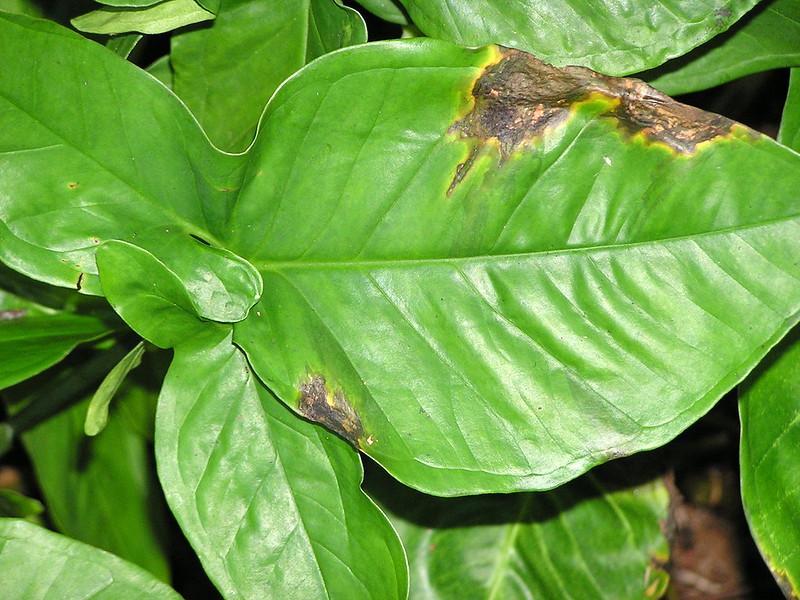
If your peace lily has grown extremely infected, you may have to remove and kill it.
Peace lilies must receive treatment as soon as possible to forestall the plants’ inevitable destruction as the fungus spreads and turns the blossoms a dark brown or even black color. The browning of peace lily blossoms can be caused by several different diseases, some of which are listed below.
Bacterial Brown Spot Disease
The bacterial brown spot disease is caused by the bacteria Erwinia and Pseudomonas.
These bacteria are located in the dead plants scattered throughout your yard and spread to your plants when water is splashed on them.
As the infection progresses, the leaves and blossoms of the peace lily will become brown. If the infection is severe, the peace lily may defoliate, wither, and eventually die.
Management And Control
Your lawn should be kept clean and free of any plant debris at all times. Remove the infected plant from the garden as soon as possible so the other plants can be saved.
Drying out the leaves also helps a lot in controlling the disease. However, if drying it out does not work, you always have the option of using one of the chemical control alternatives on the market.
Collar Rot Disease
Collar rot disease is caused by a fungus called mycelia. It is something that occurs naturally in the soil, and additional watering might aid in the process of its germination. The fungus swiftly spreads throughout the peace lily plant and damages the stems, leaves, and blossoms, causing them to become brown or black in color.
Management And Control
If you want to preserve your peace lilies from the fungus, you should not overwater them. The fungus cannot thrive in dry conditions. Keeping the soil in your home garden clean might also assist in shielding your plants from the disease.
The affected plants should be kept in isolation to prevent the fungus from spreading to other plants. Spraying the peace lilies with commercially available fungicides is another option for treating the disease.
Leaf Spot Disease
The Septoria Leaf Spot is caused by a fungus that destroys the foliage of peace lilies. In extreme circumstances, the disease can spread to the blossoms as well.
The affected leaves and blossoms could become brown or yellow and shriveled up, depending on the severity of the damage.
Management And Control
To control septoria leaf spot disease, prune out infected leaves and flowers. You might also use organic fungicides, such as those containing copper or potassium bicarbonate, which are effective against the disease without harming the peace lily plants. If organic fungicides fail to control the peace lily disease, we advise using a chemical fungicide like chlorothalonil.
Peace Lily Flowers Turning Brown Due To Pests
Pests can also cause the blossoms of peace lilies to turn a dark brown or even black color, depending on the severity of the infestation.
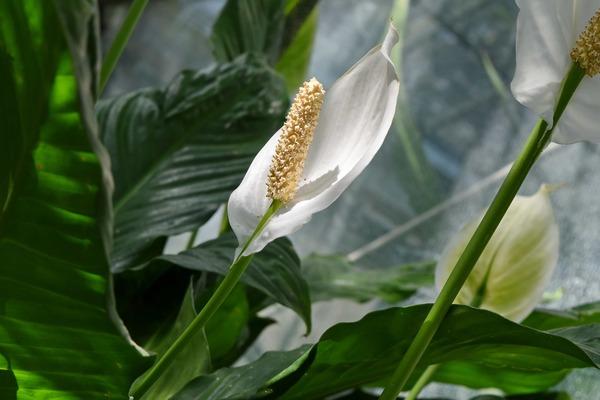
Three insects usually attack Peace Lilies: Aphids, mealy bugs, and spider mites.
Invasions of pests can also stimulate the growth of a fungus known as sooty mold, which manifests as brown or black spots on the leaves or flowers of the plant. Some common pests that attack peace lilies include thrips, aphids, and scales.
Thrips
Thrips are small-sized insects that can be black or white. They are typically seen on peace lilies’ flowers, leaves, and stems. Their damage results in the darkening of the foliage and leaves and premature drying and falling off of the plant.
Management And Control
To eliminate thrips from the leaves and blossoms of peace lilies, blast them with a stream of water. If you want to use an insecticide spray, we recommend neem oil, which is organic and safe for plants and the environment.
Aphids
Aphids, which are pear-shaped parasites, are almost always seen in groups on plants, particularly peace lilies. Aphids are not only capable of sucking the sap out of the plant’s blooms and leaves, but they are also able to pass viruses like mosaic and ringspot onto the plant that they invade. The portions that aphids have harmed begin to bend and turn brown after a while.
Management And Control
The aphids can be killed by spraying isopropyl alcohol (70%) on the foliage and some of the aphid colonies; the alcohol will cause the insects’ exoskeletons to rupture.
Spraying an organic insecticide made of neem oil and soapy water on the foliage and stems of peace lilies in order to kill aphids is another excellent way to control the aphids.
Scales
These insects with tough exoskeletons appear to be little more than bumps on the stem and foliage of a peace lily. They are similar to aphids in that they feed on the sap of leaves and flowers and secrete honeydew, encouraging the spread of sooty mold.
Management And Control
You can remove scales from your peace lily plant by using a spatula to scrape them off. However, it is much more effective to use insecticidal soap and neem oil to manage them when they are in the nymph stage. In addition, there is a wide variety of chemical insecticides available on the market that can eliminate scales.
Peace Lily Flowers Turning Brown Due To Age
Even if you follow all of the recommended care procedures, the blossoms on your peace lily could still change color and become brown or even black.
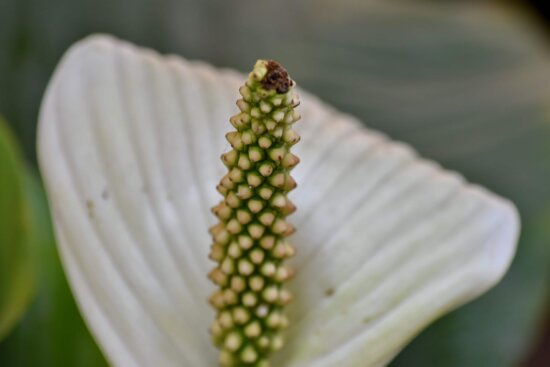
In my experience, natural aging is the most common cause of brown flowers on peace lilies.
How is it that something like this might occur? The peace lily flowers will gradually transform into a different color as they mature. When you first acquire or grow a peace lily, the flower will be unopened and have a green color.
The bloom quickly begins to spread and transform into a beautiful white color. However, when the flower begins to take on a brown color, this is a sign that it is about to pass away. After then, in a matter of days, it will wilt on its own and eventually fall off.
Conclusion
Peace lilies are an excellent option for anyone new to caring for plants or simply wants a nice houseplant that does not require much attention and maintenance.
However, the flowers of the peace lily might age prematurely, become stressed, or turn black or brown if they are not properly cared for. This is generally caused by poor housing conditions, such as intense, direct sunshine, overwatering, over-fertilization, etc.
However, there is no need to worry! Simply giving your plant the right amount of light, water, humidity, and nourishment will prevent this from happening in the first place.
Frequently Asked Questions
What do I do when peace lily flowers turn brown?
If your peace lily blooms turn brown, there’s nothing you can do but remove them from the plant. Also, remember that each stalk has a finite ability to bear flowers; once the blooms have faded, the stalk will turn brown and die. There are many causes for your Peace lilies’ browning leaves, including over- or under-watering, poor drainage, and high or low humidity.
Why are my peace lilies turning brown?
If the flower of your peace lily turns black or brown, it may be because you’ve neglected it. Low humidity, underwatering, and too much sun are the most common causes of leaf browning on peace lilies. When peace lily flowers reach the end of their life cycle, they also naturally turn brown. So it’s nothing to worry about and totally normal.
How long do flowers last on a peace lily?
Peace lilies produce one or two white hooded blooms that can persist for more than a month when they are given bright but indirect light, which is ideal for their flowering.
Peace lilies typically bloom in the spring. They might flower once again in the fall on rare occasions. However, it is important to remove the dead flowers from the plant as soon as possible to maintain its tidy appearance.
How often should you water peace lilies?
Watering a peace lily once every two days is sufficient for some indoor gardeners, but it may need to be done more frequently in arid regions. Humid environments may only require once or twice weekly watering for houseplants. Maintaining a consistently moist soil environment is essential for peace lilies. These plants need a constant supply of water to survive.
How do I know if my peace lily is dying?
Leaves turning yellow or brown, drooping leaves, brown patches on the leaves, and fading foliage are all indicators of a dying peace lily. The most common reason houseplants, especially peace lilies, die is because they are overwatered. Look for yellowing, wilting foliage, and root rot. Treat immediately and prevent watering until the problem is resolved.
How much sun does a peace lily need?
Like most other plants, peace lilies require sunlight to thrive. Not a lot, but more than 5 or 6 hours would be helpful. Peace Lilies can tolerate low to bright indirect sunlight. They’re the ideal plant for brightening up a dull space. However, its leaves and blossoms may shrivel and brown if subjected to strong, intense sunlight for too long.
How do I know if my peace lily has root rot?
If you observe a peace lily’s leaves turning yellow and notice that the plant generally appears to be wilting, you may have found evidence of root rot disease. It most certainly has root rot if its roots are also rotting. The solution is frequently as simple as removing any debris from the plant’s roots and repotting it in new, nutrient-rich soil.
Sources For Further Reading
Peace Lily – University of Florida, Institute of Food and Agricultural Sciences. (2022). Retrieved 18 October 2022, from https://gardeningsolutions.ifas.ufl.edu/plants/houseplants/peace-lily.html
Peace Lily. Clemson University Cooperative Extension Service. (2022). Retrieved 18 October 2022, from https://hgic.clemson.edu/factsheet/peace-lily/
Spathiphyllum (Mauna Loa Peace Lily, Peace Lily, Spathe Flower, White Sails) | North Carolina Extension Gardener Plant Toolbox. (2022). Retrieved 18 October 2022, from https://plants.ces.ncsu.edu/plants/spathiphyllum/
Editor’s Recommendations
Tiny Silver Bugs Houseplant Soil Plus How to Get Rid of Them?
How To Get Rid Of Water Bugs In Your Home For Good? The Ultimate Guide







